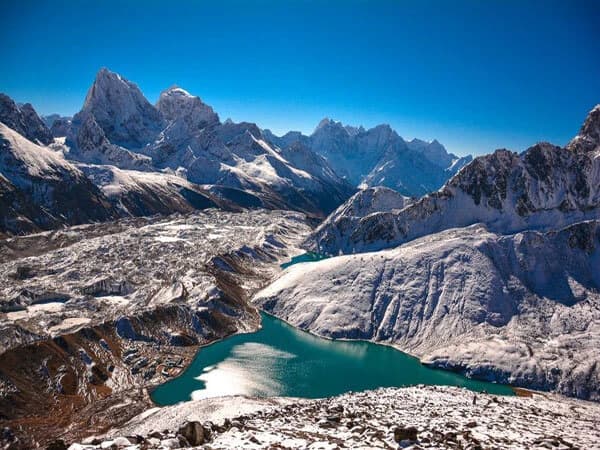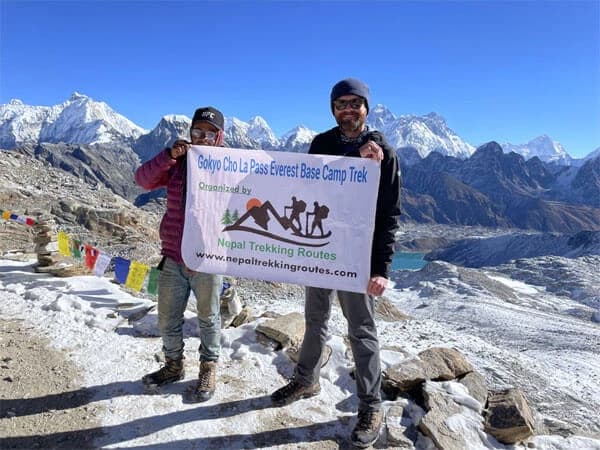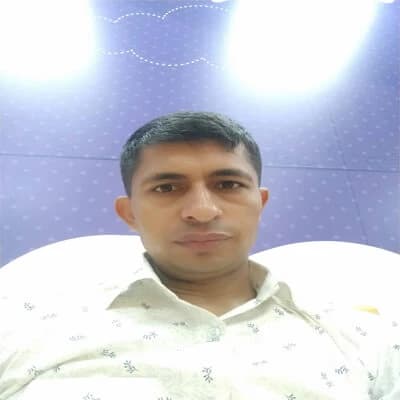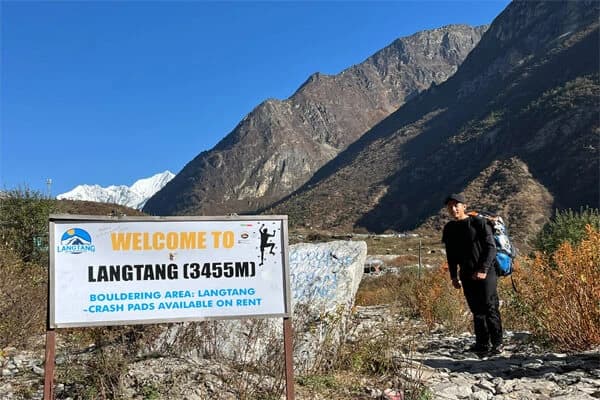This blog will walk you through the Gokyo Lake Trek itinerary, emphasizing the route, significant events, and practical advice for each day so you can confidently and eagerly organize your own journey.
One of the most breathtaking treks in the Everest region is the Gokyo Lake Trek. With fewer tourists but just as stunning views, it provides a tranquil alternative for the traditional Everest Base Camp trek. The Gokyo Lakes' glistening blue waters, the ascent to Gokyo Ri for views of the sunrise, and the up-close vistas of Makalu, Cho Oyu, Lhotse, and Everest are the main attractions. In addition to the mountains, this walk brings you to Sherpa settlements, Buddhist monasteries, and the vibrant Khumbu culture.
After a quick flight from Kathmandu to Lukla, the journey typically consists of several days of walking through traditional Sherpa towns, rhododendron woods, and suspension bridges. Before arriving in the breathtaking Gokyo Valley, trekkers take their time acclimating to the higher elevations. Many people say that one of the most memorable experiences in Nepal is witnessing the sunrise over the highest peaks in the world while standing atop Gokyo Ri.
Overview of Gokyo Lake Trek Itinerary
There is thrill and adventure at the start of the Gokyo Lake Trek. The expedition begins in Kathmandu and swiftly transports you into the Himalayas, as is the case with most trekking trips in the Everest region. Arriving at the starting location is a unique experience that combines adventure, culture, and landscapes right from the start.
Nepal's capital, Kathmandu, is where your adventure trek begins. Trekkers spend a day or two here getting ready for the journey, which includes renting or purchasing equipment, obtaining permits, and enjoying the city's many cultural attractions. In addition to being a useful stop, Kathmandu offers visitors a preview of what makes Trekking in Nepal so unique. The city's bustling marketplaces, temples, and friendly people set the mood for the journey that lies ahead.
Flight to Lukla: A Thrilling Beginning
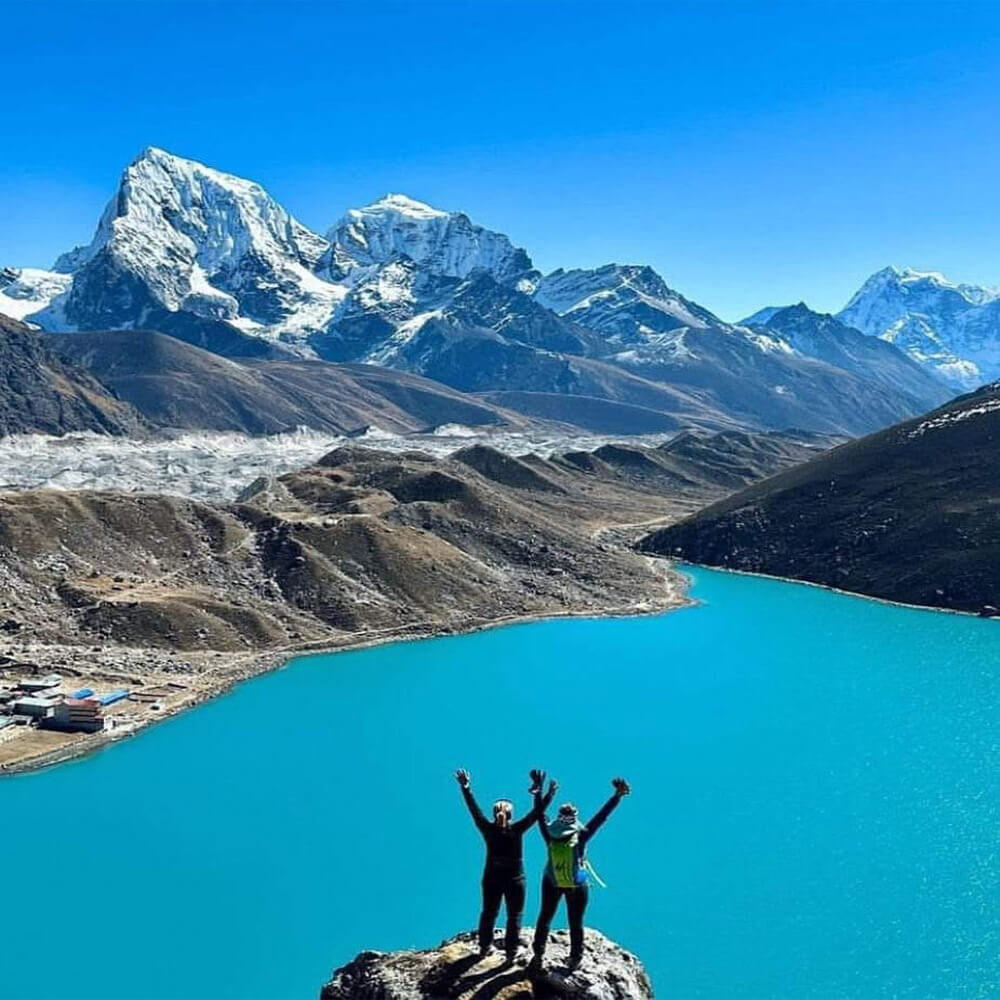
The most popular trekking routefrom Kathmandu to Lukla, the starting point of the climb, is a quick, picturesque flight. Many people consider this 30- to 35-minute trip to be among the world's most daring. Trekkers see the Himalayas for the first time as the plane flies above green hills and snow-capped peaks. It is exhilarating to land at Lukla's tiny mountain airport, which signifies the real start of the journey.
Entry into Sagarmatha National Park
The trail gradually climbs into the Khumbu Valley from Lukla, heading toward Phakding and finally Namche Bazaar. Trekkers pass through Sagarmatha National Park, a UNESCO World Heritage Site, along the route. In addition to the tallest mountains in the world, this park is home to unique vegetation and animals like Himalayan tahr and musk deer. Walking through the park serves as a reminder that this journey is about more than simply getting to Gokyo Lakes; it is also about experiencing one of the world's most unusual environments.
First Impressions of the Khumbu Region
Early in the journey, you can experience Sherpa culture over stone-paved paths and suspension bridges that span swift-moving rivers. Prayer flags, mani walls, and tiny monasteries abound in villages, demonstrating the area's significant Buddhist traditions. Since they establish the tone for the journey, these initial impressions are crucial. It serves as a reminder that this is a journey through a rich cultural landscape in addition to mountains.
More than simply arriving at a trailhead, beginning the Gokyo Lake Trek means entering the center of the Everest Region Trekking experience. Every initial step from Kathmandu to Lukla and into Sagarmatha National Park heightens the anticipation for the breathtaking mountain views, high passes, and turquoise lakes that await.
Day By Day itinerary Gokyo Trek
The Gokyo Lake Trek is a stunning journey in the Everest region that offers stunning vistas of four of the highest mountains in the world, turquoise high-altitude lakes, and an opportunity to learn about Sherpa culture. This is a comprehensive daily schedule that most trekkers adhere to.
Arrival in Kathmandu
Kathmandu, the busy capital of Nepal, is where your journey starts. Once you land, you will go to your hotel and relax. During this day, many trekkers get their equipment ready, buy any necessary items, and visit well-known cultural locations including Durbar Square and Boudhanath Stupa
Kathmandu to Lukla – Trek to Phakding
Flying to Lukla, one of the most thrilling airports in the world, is where the journey really starts. You get to see the Himalayan peaks for the first time during the brief, picturesque journey. You begin your leisurely three to four-hour walk down the Dudh Koshi River from Lukla to Phakding. Warming up for the upcoming days is a terrific method to do this.
Phakding to Namche Bazaar
You will climb steadily through pine forests today and over a number of suspension bridges, including the well-known Hillary Bridge. When you reach Namche Bazaar, the Sherpa capital greets you with vibrant markets, bakeries, and breathtaking views of Thamserku. The final stretch is tough but worthwhile. Usually, this trek takes six to seven hours.
Acclimatization Day in Namche Bazaar
This is a rest and acclimatization day because the altitude is rapidly increasing. In the Himalayas, "rest" typically refers to moderate trekking. For sweeping views of Ama Dablam, Everest, and other peaks, many trekkers make their way to the Everest View Hotel. It is crucial to stay here for two nights in order to acclimate to the thinner air and lower the chance of altitude sickness.
Namche to Dole
The trail ascends steadily after leaving Namche, offering stunning views of the Khumbu Valley. You turn toward the Gokyo Valley rather than Tengboche, as you would on the Everest Base Camp trekking journey. You arrive at the tiny community of Dole, surrounded by alpine landscape, after a few hours of ups and downs. This leg requires roughly six hours.
Dole to Machhermo
With stunning views of Cho Oyu, one of the highest peaks in the world, the walk continues with a gradual ascent through rhododendron forests, yak pastures, and ridges. You will reach the quaint village of Machhermo, which has a few lodges. The Himalayan Rescue Association frequently hosts altitude safety presentations here for trekkers.
Machhermo to Gokyo Village
When you finally arrive at Gokyo, it is a special day. The route climbs steadily, passing the first and second Gokyo Lakes after crossing a minor river. The light gleams on these turquoise glacier lakes. You will be astounded by the area's tranquility and beauty by the time you get at Gokyo village, which is close to the third lake.
Trekking to Gokyo Ri and Lakes
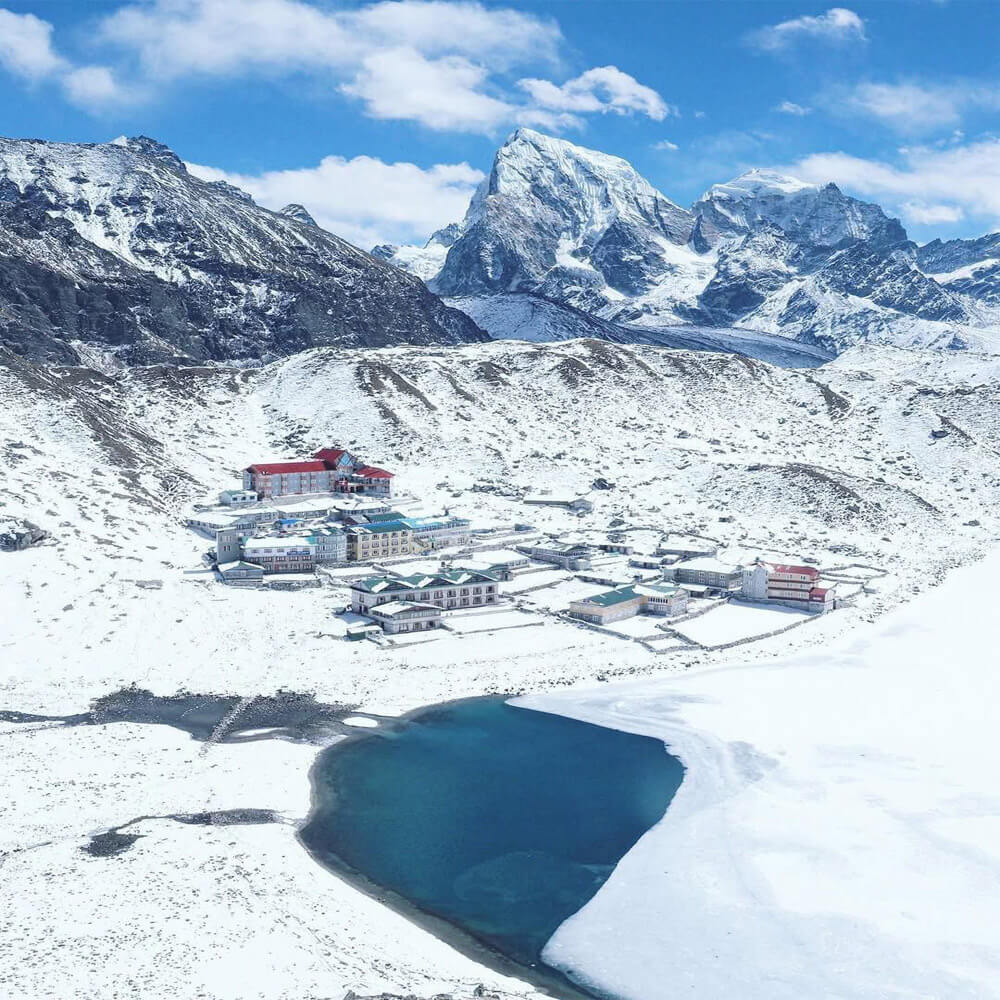
Many people view this as the trek's high point. You may enjoy expansive views of Everest, Lhotse, Makalu, and Cho Oyu all giants over 8,000 meters after an early morning climb up Gokyo Ri. Because of the altitude, the ascent is difficult and takes two to three hours, but the views are truly remarkable.
You can rest in the town and explore the remaining Gokyo Lakes during the day once you get back. Many trekkers now consider the Gokyo Lake difficulty to be moderate to difficult, manageable for those who are well-fit and have had the time to acclimate.
Gokyo to Machhermo
It is time to start the descent after reaching the gratifying peak of Gokyo Ri.
Machhermo to Namche Bazaar
You turn around and head back to Namche. You may unwind with delicious cuisine, wifi, and a vibrant atmosphere in the Sherpa capital after the lengthy yet comfortable descent. Before leaving, this is a great spot to purchase mementos.
Namche to Lukla
You spend six to seven hours on this last trekking day descending all the way back to Lukla. Most trekkers celebrate their accomplishments with a small party in the lodges, and the trail seems easier than it was at the start.
Lukla to Kathmandu
You return to Kathmandu after a quick flight, where you can relax, shop, and enjoy the cultural diversity of the city. Your adventure ends as you head home with memories of turquoise lakes, snowy peaks, and Sherpa hospitality.
Key Highlights of Everest Gokyo Ri Trek Itinerary
One of the most fulfilling treks in the Everest region, the Gokyo Lake Trek is full with memorable highlights. The ascent to Gokyo Ri, a peak that rises above the settlement of Gokyo, is one of the primary attractions.
Trekkers may enjoy breath-taking morning views of Everest, Lhotse, Makalu, and Cho Oyu, the four highest mountains in the world, from the summit. You will always remember the moment you saw these giants shimmer in golden light.
The breathtaking turquoise-blue lakes that are the reason Gokyo is so well-known are another highlight. The locals value these holy lakes for their cultural and religious significance in addition to their beauty. Along the journey, trekking through Sherpa communities offers you the opportunity to encounter friendly locals, traditional ways of life, and historic monasteries that evoke the essence of the Himalayas.
Trekkers can enjoy a more tranquil and laid-back experience on the trail itself, which has quieter routes than the crowded Everest Base Camp Trekking routes. Even though the trek is strenuous, breathtaking vistas and cross-cultural interactions await at every turn. Many trekkers claim that the highlights make the difficulties and total Gokyo Lake trek cost worthwhile, making it the ideal adventure for those who enjoy the mountains.
Best itinerary for Gokyo trek
The best Gokyo trek itinerary strikes a mix between adventure, acclimatization, and leisure to take in the breathtaking surroundings. Most hikers find that a 12- to 14-day Kathmandu to Gokyo Lakes trek itinerary works well. After a picturesque flight from Kathmandu to Lukla, the trip continues with a leisurely hike to Phakding. The trail then ascends toward the busy Sherpa settlement of Namche Bazaar, where hikers spend a day acclimating to the higher elevation. As it continues, the path leads to the villages of Dole and Machhermo across stunning rhododendron forests and alpine meadows. These pauses are ideal for resting and gaining altitude gradually.
Arriving in Gokyo village, which is next to the third turquoise lake, is the trek's high point. Trekkers can walk up to Gokyo Ri, a 5,357-meter elevation with stunning panoramic views of Everest, Lhotse, Makalu, and Cho Oyu, and spend time exploring the chain of revered Gokyo Lakes. The hike ends with a quick flight back to Kathmandu after retracing the route through Machhermo, Namche Bazaar, and Lukla.
This Gokyo Lake trekking schedule avoids haste, permits appropriate acclimatization, and gives plenty of time to take in the breathtaking scenery and Sherpa culture. There is no better way to experience the Gokyo walk since it strikes a balance between comfort and difficulty.
Can treaveler Customize Gokyo Lake Trek itinerary?
Yes, One of the best things about organizing your Gokyo Lakes Trek is that you may alter your schedule to suit your interests, time constraints, and level of fitness.
Gokyo Lake trek 12 days Itinerary
For those who have limited time but still like to take in the splendor of the Everest region, the 12-day Gokyo Lake trek itinerary is the ideal option. Before arriving in Namche Bazaar for acclimatization, the trip begins with a flight to Lukla and proceeds along the traditional route past Sherpa villages, forests, and suspension bridges. From there, the road passes Dole and Machhermo and continues steadily toward the high valley of Gokyo. Climbing Gokyo Ri, which provides sweeping views of Makalu, Cho Oyu, Lhotse, and Everest, is the highlight. After that, the journey returns to Lukla in order to catch a flight back to Kathmandu.
Gokyo lake trek 14 days itinerary
Although it takes a same path, the 14-day Gokyo Lake trek Itinerary gives you extra time to explore and acclimate. Trekkers begin their journey in Lukla and travel at a leisurely pace through Phakding and Namche Bazaar, with an additional day for relaxation and cultural exploration. As the trail ascends, it passes through peaceful communities like Machhermo and Dole before arriving in Gokyo. Trekkers can ascend Gokyo Ri for stunning Himalayan views and explore a number of the blue lakes. With two extra days, this Gokyo LakesNepal trekking plan guarantees a more relaxed experience, more cultural engagement, and improved altitude adaptation before heading back to Lukla and taking a flight back to Kathmandu.
Gokyo Cho La Pass Trek itinerary
The Gokyo Cho La Pass Trek Itinerary is a popular option for trekkers who want to extend their journey. It mixes the beauty of Gokyo Lakes with the difficulty of traversing the high Cho La Pass before continuing on to Everest Base Camp. You have the opportunity to see both famous locations on this route in a single journey. This Gokyo Lake to Everest Base Camp route crosses the dramatic Cho La Pass, linking the peaceful Gokyo Valley with the famous EBC trekking trail, offering lakes, glaciers, and stunning Himalayan panoramas.
Gokyo Renjo La Pass Trek itinerary
The Gokyo Lake Renjo La Pass Trek Itinerary is another thrilling choice. It crosses the Renjo La Pass and provides sweeping views of Makalu, Lhotse, Everest, and other Himalayan giants. For people who favor peaceful routes and prefer a less crowded experience while still enjoying breathtaking scenery, this version is ideal. You can customize Gokyo itineraries to fit your needs, whether you are looking for a quick version, a strenuous extension, or a tranquil diversion.
Difficulty Level of the Gokyo Lake Trek
At a moderate level, the Gokyo Lake trek difficulty is comparable to some of the other well-known treks in the Everest region. This indicates that the majority of trekkers may successfully finish it with some preparation and a respectable level of fitness. Long walking days, typically lasting five to seven hours, with modest ascents and descents, are part of the trail. The walk takes you to high altitudes, with Gokyo Ri rising at over 5,300 meters, although it does not need expert climbing skills. Every step feels more difficult in the thin air, and acclimatization is crucial to lowering the risk of altitude sickness.
The Gokyo Cho La Pass trek difficulty rating is higher for those who combine it with the well-known high pass route. Above 5,400 meters, the Cho La Pass features rocky terrain, icy portions, and a difficult ascent. It takes endurance, the right equipment, and favorable weather to cross. Beautiful vistas of Everest, Lhotse, and other Himalayan giants are the reward for the challenge.
Finally, the Gokyo Lake journey is appropriate for trekkers seeking a less crowded option to the traditional Everest Base Camp trek that nevertheless offers stunning views. Most individuals can finish this trek with consistent preparation, a Gokyo Valley trekking days plan, and gradual acclimatization. It is among the greatest options for adventurers who desire both difficulty and beauty since it is neither too easy nor too difficult—rather, it falls somewhere in the middle.
Best Seasons to Follow the Itinerary
Because weather and trail conditions can significantly impact your experience, it is crucial to choose the appropriate season for the Gokyo Lakes trek. Although the mountains are stunning throughout the year, certain months are safer and more fun than others. This guide explains the optimal seasons and what to anticipate.
Gokyo Lake Trek in Spring Season (March to May)
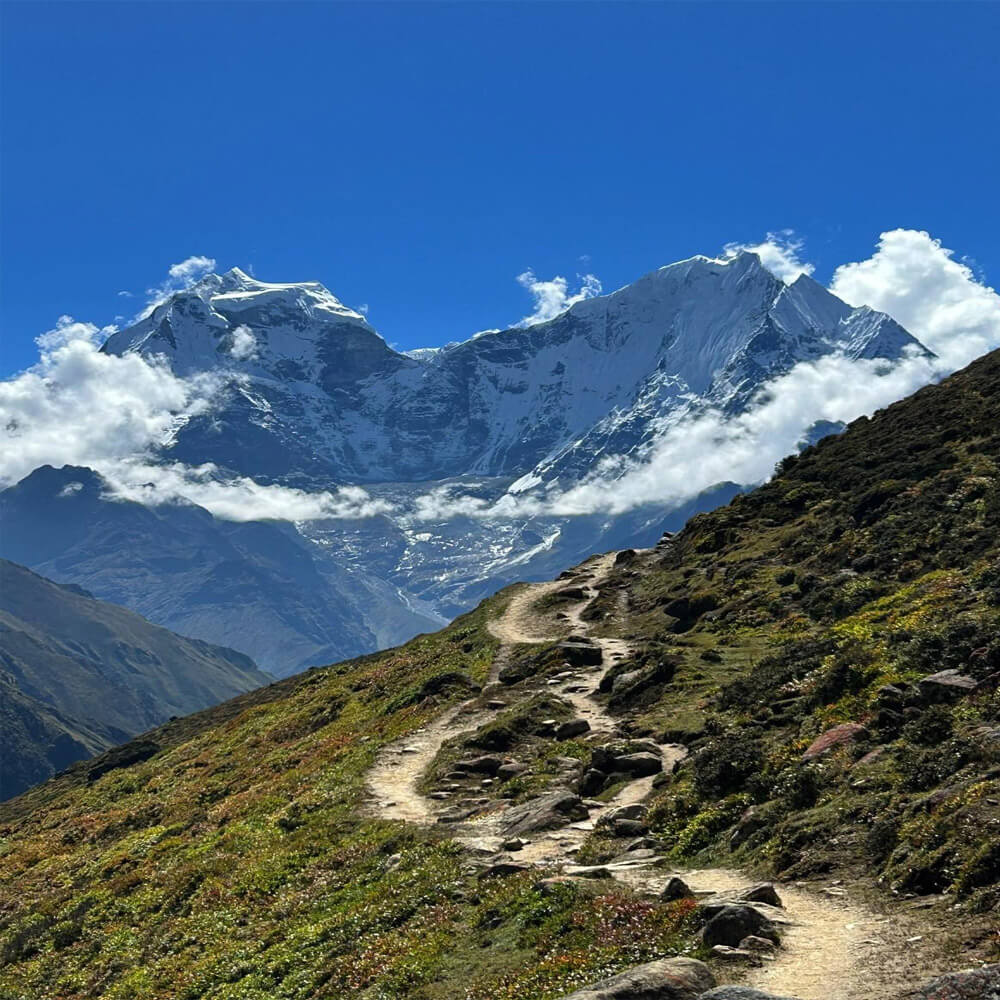
One of the best seasons to trek the Gokyo Lakes is in the spring. The days are longer, the temperature is pleasant, and the sky are typically clear, providing breathtaking views of peaks like Everest and Lhotse. Along the way, rhododendron forests bloom, bringing color to your travels. This time of year is perfect for taking pictures and enjoying the beauty of nature without being too cold. At higher elevations, the evenings might still be cold, but the daytime temperatures are pleasant.
Gokyo Lake Trek in Autumn Season (September to November)
Another great time of year for the walk is in the fall. The air is pure and fresh after the rain, providing breathtaking sweeping views of the Himalayan ranges. Trekking is safer because the trails are more sturdy and less muddy than during the wet season. The evenings are cool but tolerable with appropriate clothes, while the daytime temps are comfortable. Teahouses may be busier in the fall since trekkers are more likely to come, but the breathtaking scenery makes the trip worthwhile.
Gokyo Lake Trek in Winter Season (December to February)
The walk may feel more tranquil in the winter because there are fewer trekkers and quieter trails. But the temperature drops a lot, particularly at higher altitudes like Gokyo Ri. Paths covered with snow can become slippery and difficult to navigate in certain places. Experienced trekkers can travel in the winter, but beginners may find the cold and shortened daylight hours challenging. Winter might be enjoyable if you like being alone and do not mind the cold.
Gokyo Lake Trek in Monsoon Season(June to August)
The Gokyo Lakes trip is least enjoyable during the monsoon season. Rivers may swell, landslides may occur, and routes may become muddy and slippery due to heavy rainfall. There is limited photography because clouds frequently obscure the mountain views. Only very experienced trekkers or those looking for adventure in wet weather should try the walk during these months.
In general, spring and autumn are the best time for Gokyo Lakes trek seasons. Trekkers can enjoy the natural beauty and cultural experiences along the path throughout these seasons because they offer clear skies, comfortable temperatures, and safer trail conditions. Trekking during these months guarantees the most fulfilling and unforgettable experience.
Permits and Preparations for Gokyo Lake Trek
For the Gokyo Lake Trek to be both safe and fun, the right permits and preparation are necessary. Legal requirements, physical condition, and gear for high-altitude trekking are all important in Nepal.
Permits Required During the Gokyo Lake Trek
There are two type of trekking permit require for Everest Gokyo lake Trek:
- TIMS Card (Trekkers’ Information Management System): All trekkers in Nepal are required to have this card, which aids in visitor tracking for authorities. You may get it in Pokhara or Kathmandu.
- Sagarmatha National Park Permit: This park admission permit is necessary because Gokyo Lake is located within Sagarmatha National Park. It guarantees environmental preservation and supports regional conservation initiatives. You will need to carry both permits on the journey and have them examined at trailside checkpoints.
Fitness Preparation for Everest Gokyo Lake trek
Trekking in Nepal means spending a lot of time on steep, rough trails that are frequently higher than 4,000 meters. Trekkers should get ready by strengthening their legs, trekking with a rucksack, and performing frequent aerobic activities. In order to prevent altitude sickness, proper acclimatization is essential.
Trekking Gear and Equipment for Gokyo lake trek
Trekking boots, waterproof coats, helmets, gloves, and warm clothing for high elevations are all necessary pieces of equipment. Additionally advised are a decent sleeping bag, trekking poles, and a cozy backpack. Sunscreen and sunglasses are essential for protection from the intense mountain sun.
Other Preparations
- Bring plenty of water and energy-boosting snacks.
- Obtain travel insurance that includes coverage for high-altitude helicopter evacuation and trekking.
- Discover the fundamentals of first aid and how to identify the signs of altitude sickness.
Alternate Lake Treks in Nepal
Beyond the well-known Gokyo Lake trek, Nepal has many other high-altitude lakes that provide distinctive trekking opportunities. For tourists looking for calm settings, stunning scenery, and cultural interactions with local people, these lake treks are ideal.
Tilicho Lake Trek
The Annapurna region is home to Tilicho Lake, one of the highest lakes in the world at nearly 4,900 meters. The trek is difficult because to the rough terrain, high elevation, and steep ascents. Trekkers travel through traditional communities, alpine sceneries, and breathtaking mountain views. For those looking for adventure and secluded trekking, Tilicho Lake is the perfect destination.
Panch Pokhari Trek
The Langtang region is home to the Panch Pokhari (Five Sacred Lakes) trek, which blends religious significance with scenic beauty. Both Buddhists and Hindus regard the lakes as sacred. This trek, which offers beautiful views of the mountains, rivers, and forests, is moderately difficult. It offers serenity and cultural immersion and is less crowded than the well-known Everest or Annapurna Region Treks.
Gosaikunda Trek
Located in the Langtang region, Gosaikunda Lake is a glacial lake that holds significant spiritual value, particularly during the Janai Purnima celebration. The trek consists of high-altitude climbing up to 4,380 meters on moderate to difficult routes. Trekkers take pleasure in encounters with Tamang people, alpine meadows, and rhododendron forests.
Other Notable Lake Treks
- Rara Lake Trek: The country's largest lake, Rara, is situated in western Nepal and is encircled by beautiful wilderness and Rara National Park.
- Khopra Lake Trek: This journey in the Annapurna region offers peace and fewer tourists while rewarding trekkers with expansive vistas of Dhaulagiri and Machapuchhre.
These alternate lake treks provide a blend of natural beauty, culture, and adventure. For trekkers looking for less-traveled paths, spiritual encounters, and stunning Himalayan landscapes, these are great choices. Every lake trek offers a different and remarkable experience, whether it is in Langtang, Annapurna, or far-western Nepal.
Conclusion: Gokyo Lake Trek Itinerary
One of the most rewarding treks in the Everest region is the Gokyo Lake Trek. Beautiful blue lakes, expansive views of Makalu, Cho Oyu, Lhotse, and Everest from Gokyo Ri, and an opportunity to immerse oneself in Sherpa culture in tranquil high-altitude communities are all available. This trip is ideal for nature lovers and photographers since it offers a more tranquil, contemplative trekking experience than the more crowded Everest Base Camp route.
Nepal Trekking Routes can further simplify and secure the Gokyo Lake Trek. We offer knowledgeable guides, porters, and assistance in obtaining the required permits, such as the TIMS card and admission to Sagarmatha National Park. With our help, trekkers may concentrate on enjoying the landscape, the lakes and mountains, and the customs of the area. Acclimatization, pace, and planning all contribute to a safe and enjoyable trek. In the heart of the Himalayas, the Gokyo Lake Trek is an incredible experience when paired with our expert advice.
Frequently Asked Question
How long is the Gokyo Lakes Trek?
The trek usually takes 12–14 days, including flights from and back to Kathmandu. This allows time for acclimatization and exploring Gokyo Ri and the lakes.
What is the best season to do this trek?
Spring (March–May) and autumn (September–November) are the best times. The weather is clear, trails are safe, and mountain views are spectacular.
How difficult is the Gokyo Lakes Trek?
Gokyo lake trekking difficulty is a moderate to challenging trek. Trekkers walk 5–7 hours daily, face steep trails, and reach high altitudes, up to 5,357 meters at Gokyo Ri. Proper fitness and acclimatization are essential.
Do I need permits for this trek?
Yes, a TIMS card and Sagarmatha National Park permit are required. These can be arranged in Kathmandu or through trekking agencies.
Can I hire guides or porters?
Yes, hiring experienced guides and porters is recommended. They help with navigation, carrying luggage, and ensuring safety, making the trek smoother and more enjoyable.
What are Gokyo Ri trek highlights?
The Gokyo Ri trek highlights include breathtaking views of Everest, Lhotse, Makalu, and Cho Oyu, the sparkling turquoise Gokyo Lakes, the dramatic Ngozumpa Glacier, and peaceful Sherpa villages. Trekkers enjoy fewer crowds than Everest Base Camp, rich local culture, and a perfect blend of adventure, beauty, and high-altitude exploration.
What is Gokyo Lakes trek distance and duration?
The Gokyo Valley trek covers about 92 kilometers round trip and usually takes 12 to 14 days, including acclimatization and exploration.





